traction control MAZDA MODEL CX-9 2009 Owners Manual (in English)
[x] Cancel search | Manufacturer: MAZDA, Model Year: 2009, Model line: MODEL CX-9, Model: MAZDA MODEL CX-9 2009Pages: 538, PDF Size: 12.18 MB
Page 151 of 538
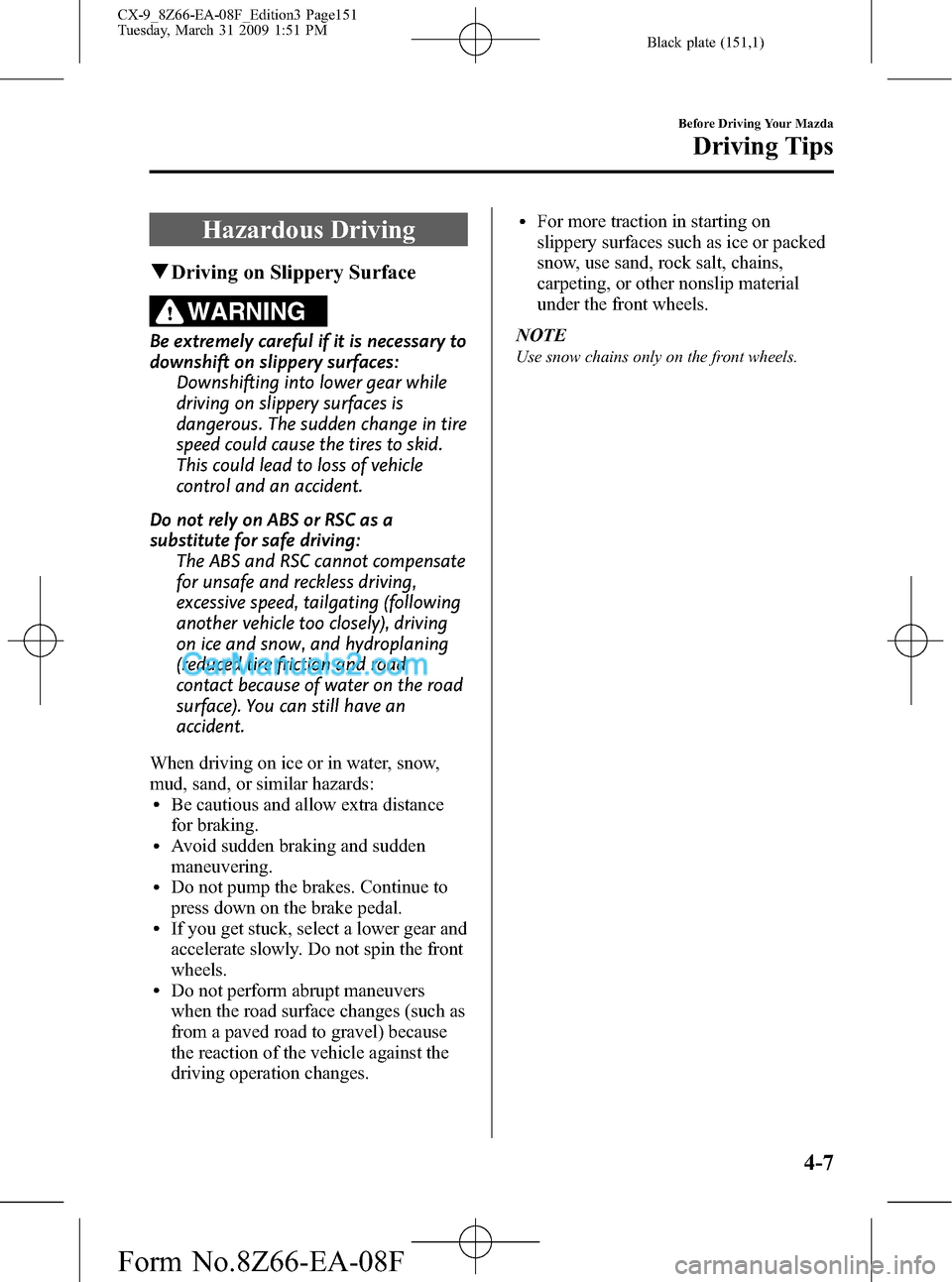
Black plate (151,1)
Hazardous Driving
qDriving on Slippery Surface
WARNING
Be extremely careful if it is necessary to
downshift on slippery surfaces:
Downshifting into lower gear while
driving on slippery surfaces is
dangerous. The sudden change in tire
speed could cause the tires to skid.
This could lead to loss of vehicle
control and an accident.
Do not rely on ABS or RSC as a
substitute for safe driving:
The ABS and RSC cannot compensate
for unsafe and reckless driving,
excessive speed, tailgating (following
another vehicle too closely), driving
on ice and snow, and hydroplaning
(reduced tire friction and road
contact because of water on the road
surface). You can still have an
accident.
When driving on ice or in water, snow,
mud, sand, or similar hazards:
lBe cautious and allow extra distance
for braking.
lAvoid sudden braking and sudden
maneuvering.
lDo not pump the brakes. Continue to
press down on the brake pedal.
lIf you get stuck, select a lower gear and
accelerate slowly. Do not spin the front
wheels.
lDo not perform abrupt maneuvers
when the road surface changes (such as
from a paved road to gravel) because
the reaction of the vehicle against the
driving operation changes.
lFor more traction in starting on
slippery surfaces such as ice or packed
snow, use sand, rock salt, chains,
carpeting, or other nonslip material
under the front wheels.
NOTE
Use snow chains only on the front wheels.
Before Driving Your Mazda
Driving Tips
4-7
CX-9_8Z66-EA-08F_Edition3 Page151
Tuesday, March 31 2009 1:51 PM
Form No.8Z66-EA-08F
Page 167 of 538
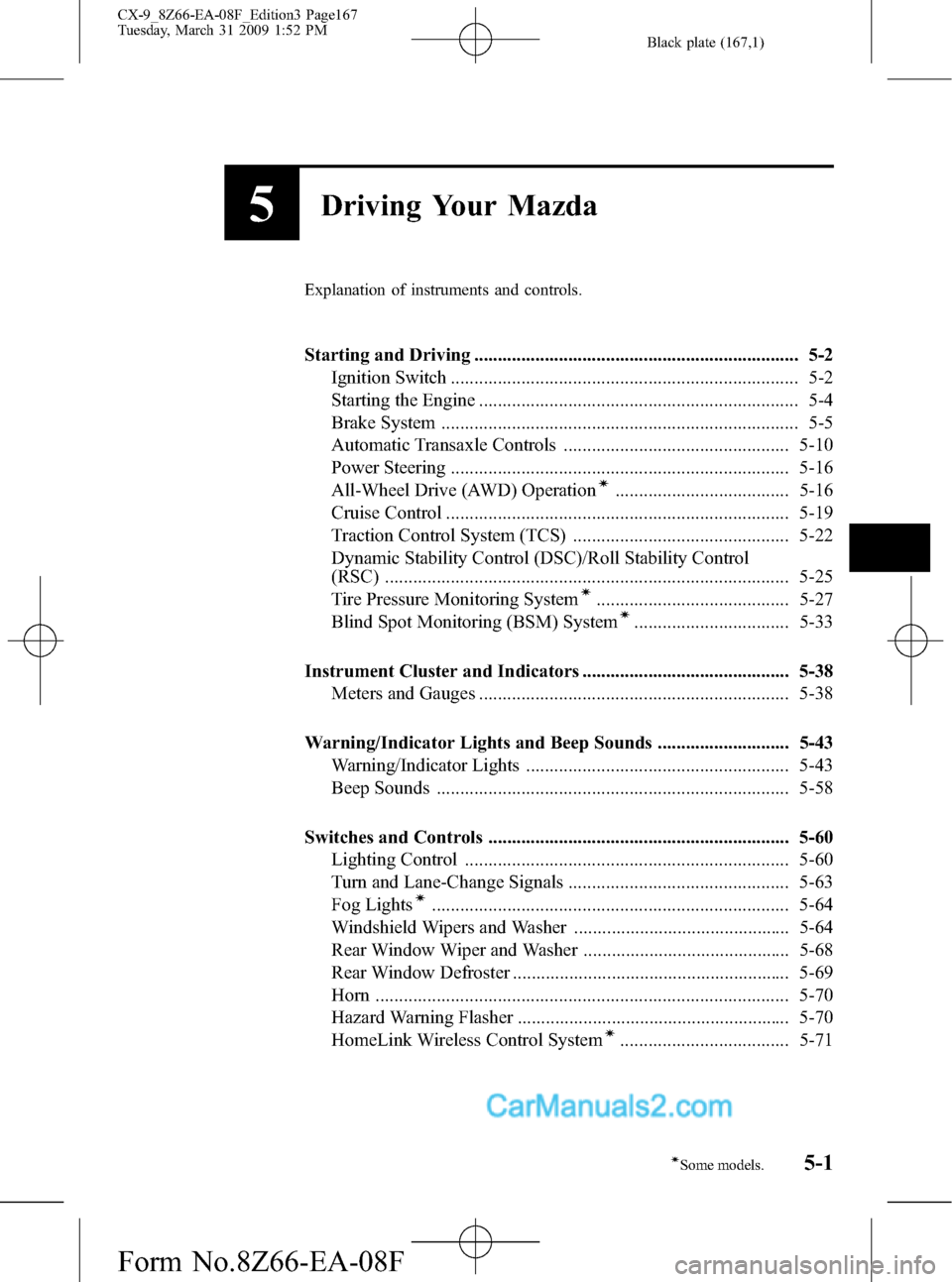
Black plate (167,1)
5Driving Your Mazda
Explanation of instruments and controls.
Starting and Driving ..................................................................... 5-2
Ignition Switch .......................................................................... 5-2
Starting the Engine .................................................................... 5-4
Brake System ............................................................................ 5-5
Automatic Transaxle Controls ................................................ 5-10
Power Steering ........................................................................ 5-16
All-Wheel Drive (AWD) Operation
í..................................... 5-16
Cruise Control ......................................................................... 5-19
Traction Control System (TCS) .............................................. 5-22
Dynamic Stability Control (DSC)/Roll Stability Control
(RSC) ...................................................................................... 5-25
Tire Pressure Monitoring System
í......................................... 5-27
Blind Spot Monitoring (BSM) Systemí................................. 5-33
Instrument Cluster and Indicators ............................................ 5-38
Meters and Gauges .................................................................. 5-38
Warning/Indicator Lights and Beep Sounds ............................ 5-43
Warning/Indicator Lights ........................................................ 5-43
Beep Sounds ........................................................................... 5-58
Switches and Controls ................................................................ 5-60
Lighting Control ..................................................................... 5-60
Turn and Lane-Change Signals ............................................... 5-63
Fog Lights
í............................................................................ 5-64
Windshield Wipers and Washer .............................................. 5-64
Rear Window Wiper and Washer ............................................ 5-68
Rear Window Defroster ........................................................... 5-69
Horn ........................................................................................ 5-70
Hazard Warning Flasher .......................................................... 5-70
HomeLink Wireless Control System
í.................................... 5-71
5-1íSome models.
CX-9_8Z66-EA-08F_Edition3 Page167
Tuesday, March 31 2009 1:52 PM
Form No.8Z66-EA-08F
Page 188 of 538
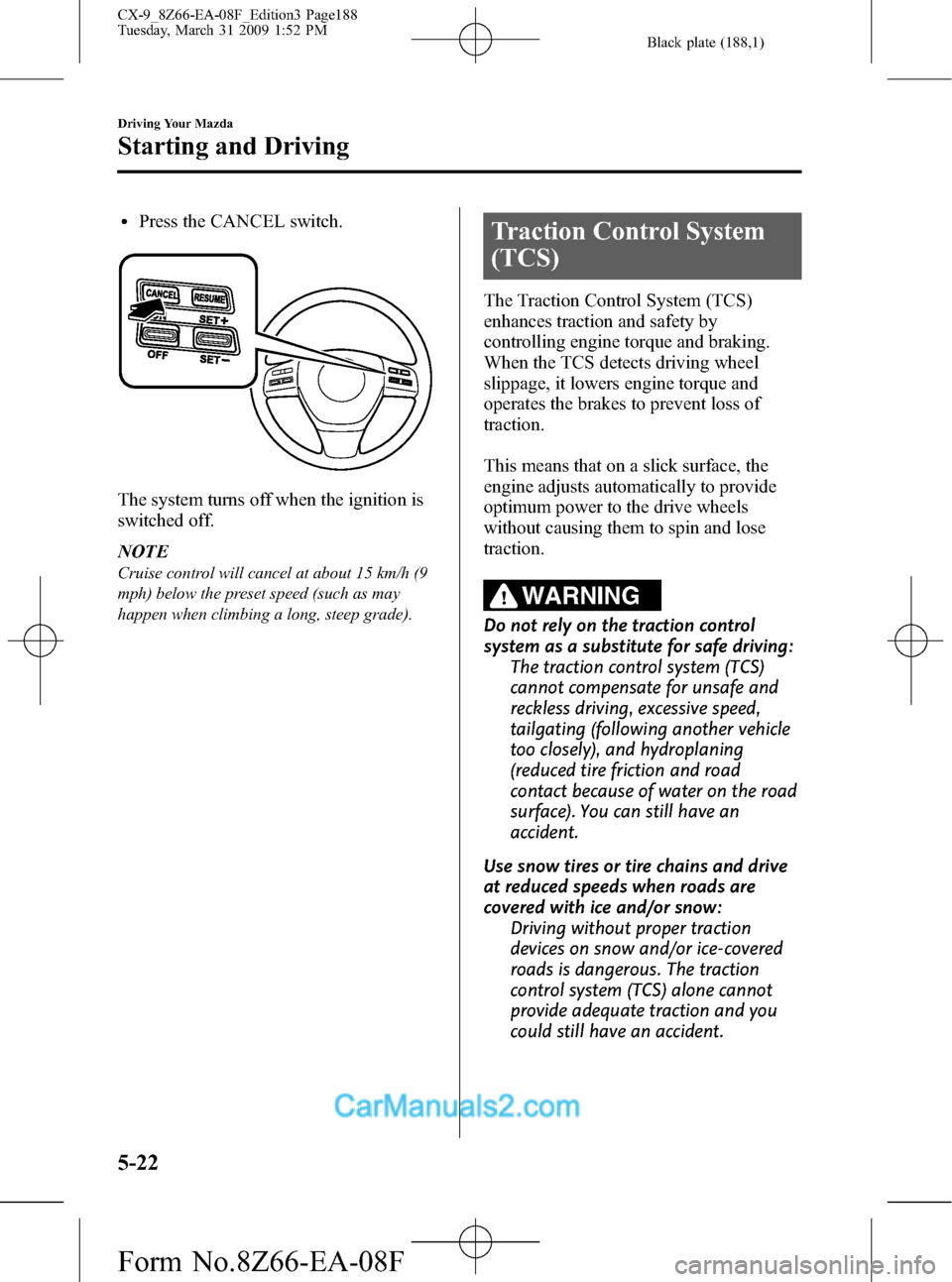
Black plate (188,1)
lPress the CANCEL switch.
The system turns off when the ignition is
switched off.
NOTE
Cruise control will cancel at about 15 km/h (9
mph) below the preset speed (such as may
happen when climbing a long, steep grade).
Traction Control System
(TCS)
The Traction Control System (TCS)
enhances traction and safety by
controlling engine torque and braking.
When the TCS detects driving wheel
slippage, it lowers engine torque and
operates the brakes to prevent loss of
traction.
This means that on a slick surface, the
engine adjusts automatically to provide
optimum power to the drive wheels
without causing them to spin and lose
traction.
WARNING
Do not rely on the traction control
system as a substitute for safe driving:
The traction control system (TCS)
cannot compensate for unsafe and
reckless driving, excessive speed,
tailgating (following another vehicle
too closely), and hydroplaning
(reduced tire friction and road
contact because of water on the road
surface). You can still have an
accident.
Use snow tires or tire chains and drive
at reduced speeds when roads are
covered with ice and/or snow:
Driving without proper traction
devices on snow and/or ice-covered
roads is dangerous. The traction
control system (TCS) alone cannot
provide adequate traction and you
could still have an accident.
5-22
Driving Your Mazda
Starting and Driving
CX-9_8Z66-EA-08F_Edition3 Page188
Tuesday, March 31 2009 1:52 PM
Form No.8Z66-EA-08F
Page 298 of 538
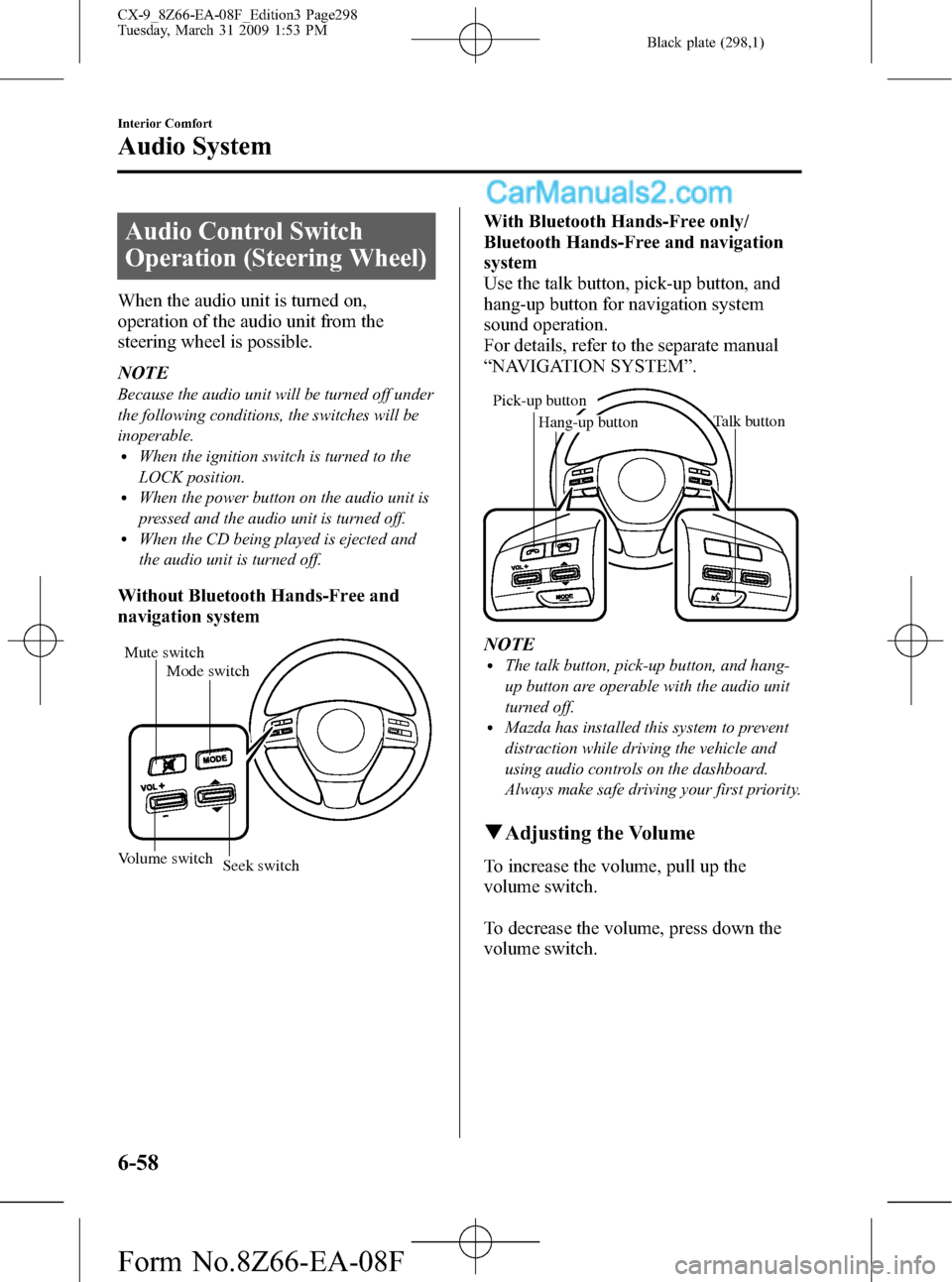
Black plate (298,1)
Audio Control Switch
Operation (Steering Wheel)
When the audio unit is turned on,
operation of the audio unit from the
steering wheel is possible.
NOTE
Because the audio unit will be turned off under
the following conditions, the switches will be
inoperable.
lWhen the ignition switch is turned to the
LOCK position.
lWhen the power button on the audio unit is
pressed and the audio unit is turned off.
lWhen the CD being played is ejected and
the audio unit is turned off.
Without Bluetooth Hands-Free and
navigation system
Mute switch
Volume switchSeek switch Mode switch
With Bluetooth Hands-Free only/
Bluetooth Hands-Free and navigation
system
Use the talk button, pick-up button, and
hang-up button for navigation system
sound operation.
For details, refer to the separate manual
“NAVIGATION SYSTEM”.
Talk button
Hang-up button Pick-up button
NOTElThe talk button, pick-up button, and hang-
up button are operable with the audio unit
turned off.
lMazda has installed this system to prevent
distraction while driving the vehicle and
using audio controls on the dashboard.
Always make safe driving your first priority.
qAdjusting the Volume
To increase the volume, pull up the
volume switch.
To decrease the volume, press down the
volume switch.
6-58
Interior Comfort
Audio System
CX-9_8Z66-EA-08F_Edition3 Page298
Tuesday, March 31 2009 1:53 PM
Form No.8Z66-EA-08F
Page 356 of 538
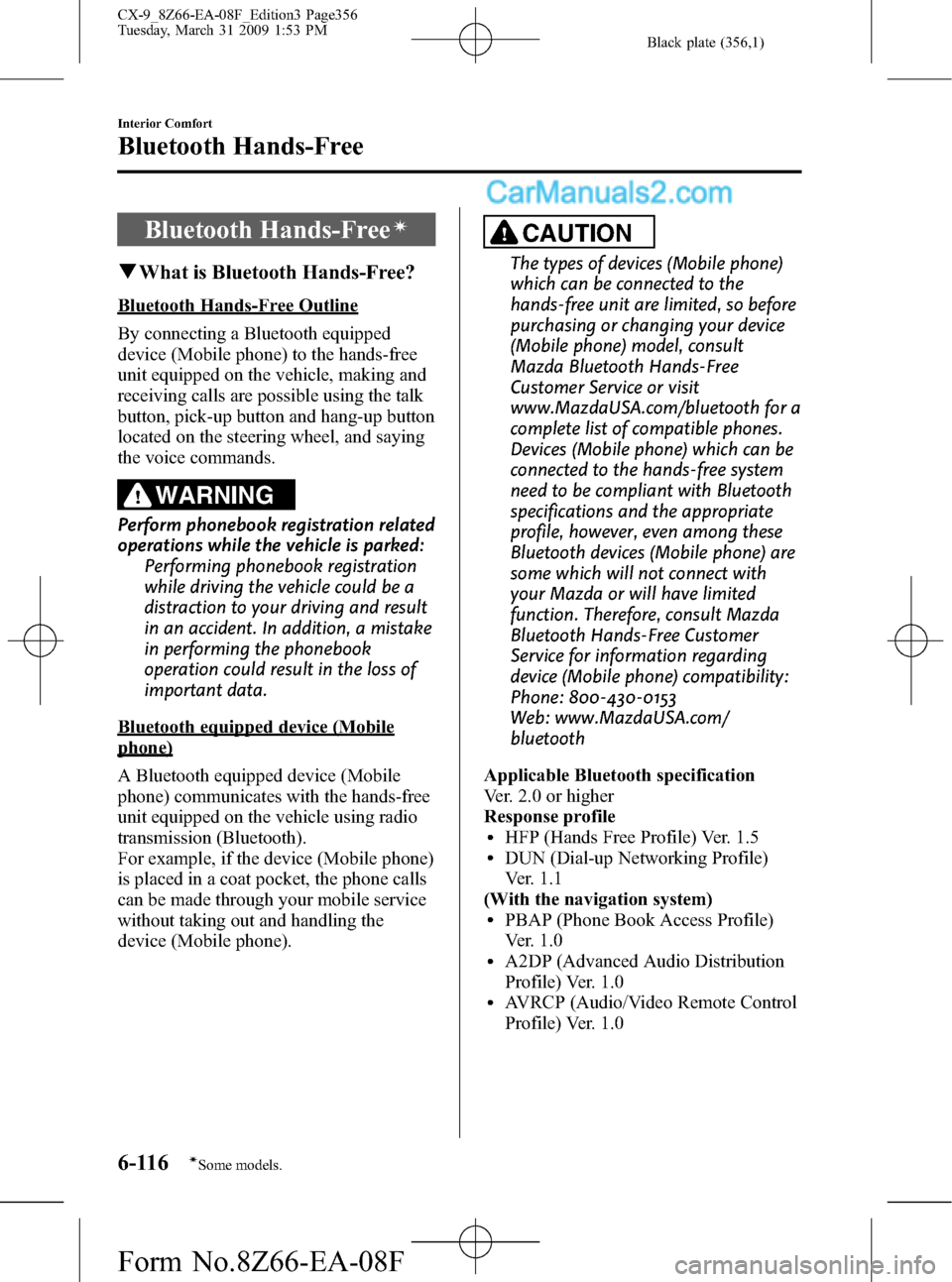
Black plate (356,1)
Bluetooth Hands-Freeí
qWhat is Bluetooth Hands-Free?
Bluetooth Hands-Free Outline
By connecting a Bluetooth equipped
device (Mobile phone) to the hands-free
unit equipped on the vehicle, making and
receiving calls are possible using the talk
button, pick-up button and hang-up button
located on the steering wheel, and saying
the voice commands.
WARNING
Perform phonebook registration related
operations while the vehicle is parked:
Performing phonebook registration
while driving the vehicle could be a
distraction to your driving and result
in an accident. In addition, a mistake
in performing the phonebook
operation could result in the loss of
important data.
Bluetooth equipped device (Mobile
phone)
A Bluetooth equipped device (Mobile
phone) communicates with the hands-free
unit equipped on the vehicle using radio
transmission (Bluetooth).
For example, if the device (Mobile phone)
is placed in a coat pocket, the phone calls
can be made through your mobile service
without taking out and handling the
device (Mobile phone).
CAUTION
The types of devices (Mobile phone)
which can be connected to the
hands-free unit are limited, so before
purchasing or changing your device
(Mobile phone) model, consult
Mazda Bluetooth Hands-Free
Customer Service or visit
www.MazdaUSA.com/bluetooth for a
complete list of compatible phones.
Devices (Mobile phone) which can be
connected to the hands-free system
need to be compliant with Bluetooth
specifications and the appropriate
profile, however, even among these
Bluetooth devices (Mobile phone) are
some which will not connect with
your Mazda or will have limited
function. Therefore, consult Mazda
Bluetooth Hands-Free Customer
Service for information regarding
device (Mobile phone) compatibility:
Phone: 800-430-0153
Web: www.MazdaUSA.com/
bluetooth
Applicable Bluetooth specification
Ver. 2.0 or higher
Response profile
lHFP (Hands Free Profile) Ver. 1.5lDUN (Dial-up Networking Profile)
Ver. 1.1
(With the navigation system)
lPBAP (Phone Book Access Profile)
Ver. 1.0
lA2DP (Advanced Audio Distribution
Profile) Ver. 1.0
lAVRCP (Audio/Video Remote Control
Profile) Ver. 1.0
6-116
Interior Comfort
íSome models.
Bluetooth Hands-Free
CX-9_8Z66-EA-08F_Edition3 Page356
Tuesday, March 31 2009 1:53 PM
Form No.8Z66-EA-08F
Page 496 of 538

Black plate (496,1)
Uniform Tire Quality Grading System (UTQGS)
This information relates to the tire grading system developed by the U.S. National
Highway Traffic Safety Administration for grading tires by tread wear, traction, and
temperature performance.
qTread Wear
The tread wear grade is a comparative rating based on the wear rate of the tire when tested
under controlled conditions on a specified government test course.
For example, a tire graded 150 would wear one-and-a-half times as well on the government
course as a tire graded 100.
The relative performance of tires depends upon the actual conditions of their use, however,
and may depart significantly from the norm because of variations in driving habits, service
practices and differences in road characteristics and climate.
qTraction-AA, A, B, C
The traction grades, from highest to lowest, are AA, A, B, and C. These grades represent
the tire's ability to stop on wet pavement as measured under controlled conditions on
specified government test surfaces of asphalt and concrete. A tire marked C may have poor
traction performance.
WARNING
The traction grade assigned to this tire is based on braking (straight ahead) traction
tests and does not include acceleration cornering (turning), hydroplaning, or peak
traction characteristics.
qTemperature-A, B, C
The temperature grades A (the highest), B, and C, represent the tire's resistance to the
generation of heat and its ability to dissipate heat when tested under controlled conditions
on a specified indoor laboratory test wheel.
Sustained high temperature can cause the material of the tire to degenerate and reduce tire
life, and excessive temperatures can lead to sudden tire failure.
Grade C corresponds to a level of performance which all passenger vehicle tires must meet
under the Federal Motor Vehicle Safety Standard No. 109. Grades B and A represent
higher levels of performance on the laboratory test wheel than the minimum required by
law.
9-24
Customer Information and Reporting Safety Defects
Uniform Tire Quality Grading System (UTQGS)
CX-9_8Z66-EA-08F_Edition3 Page496
Tuesday, March 31 2009 1:55 PM
Form No.8Z66-EA-08F
Page 501 of 538

Black plate (501,1)
Tread Wear, Traction and Temperature Grades
Tread wear:The tread wear grade is a comparative rating based on the wear rate of the tire
when tested under controlled conditions on a specified government test course. For
example, a tire graded 150 would wear one and one-half (1 1/2) times as well on the
government course as a tire graded 100.
Traction:The traction grades, from highest to lowest are AA, A, B, and C. The grades
represent the tire's ability to stop on wet pavement as measured under controlled conditions
on specified government test surfaces of asphalt and concrete. A tire marked C may have
poor traction performance.
Temperature:The temperature grades are A (the highest), B and C, representing the tire's
resistance to the generation of heat and its ability to dissipate heat when tested under
controlled conditions on a specified indoor laboratory test wheel.
Snow Tires
In some heavy snow areas, local governments may require true snow tires, those with very
deeply cut tread. These tires should only be used in pairs or placed on all four wheels.
Make sure you purchase snow tires that are the same size and construction type as the other
tires on your vehicle.
SAFETY WARNING
The following safety warning appears on the tire's sidewall.
SERIOUS INJURY MAY RESULT FROM:
lEXPLOSION OF TIRE/RIM ASSEMBLY DUE TO IMPROPER MOUNTING-
MATCH TIRE DIAMETER TO RIM DIAMETER; NEVER EXCEED 40 psi (275 kPa)
TO SEAT BEADS-ONLY SPECIALLY TRAINED PERSONS SHOULD MOUNT
TIRES.
lTIRE FAILURE DUE TO UNDER-INFLATION/OVERLOADING/DAMAGE-
FOLLOW OWNER'S MANUAL AND PLACARD IN VEHICLE-FREQUENTLY
CHECK INFLATION PRESSURE AND INSPECT FOR DAMAGE.
Customer Information and Reporting Safety Defects
Tire Information (except Canada)
9-29
CX-9_8Z66-EA-08F_Edition3 Page501
Tuesday, March 31 2009 1:55 PM
Form No.8Z66-EA-08F
Page 537 of 538
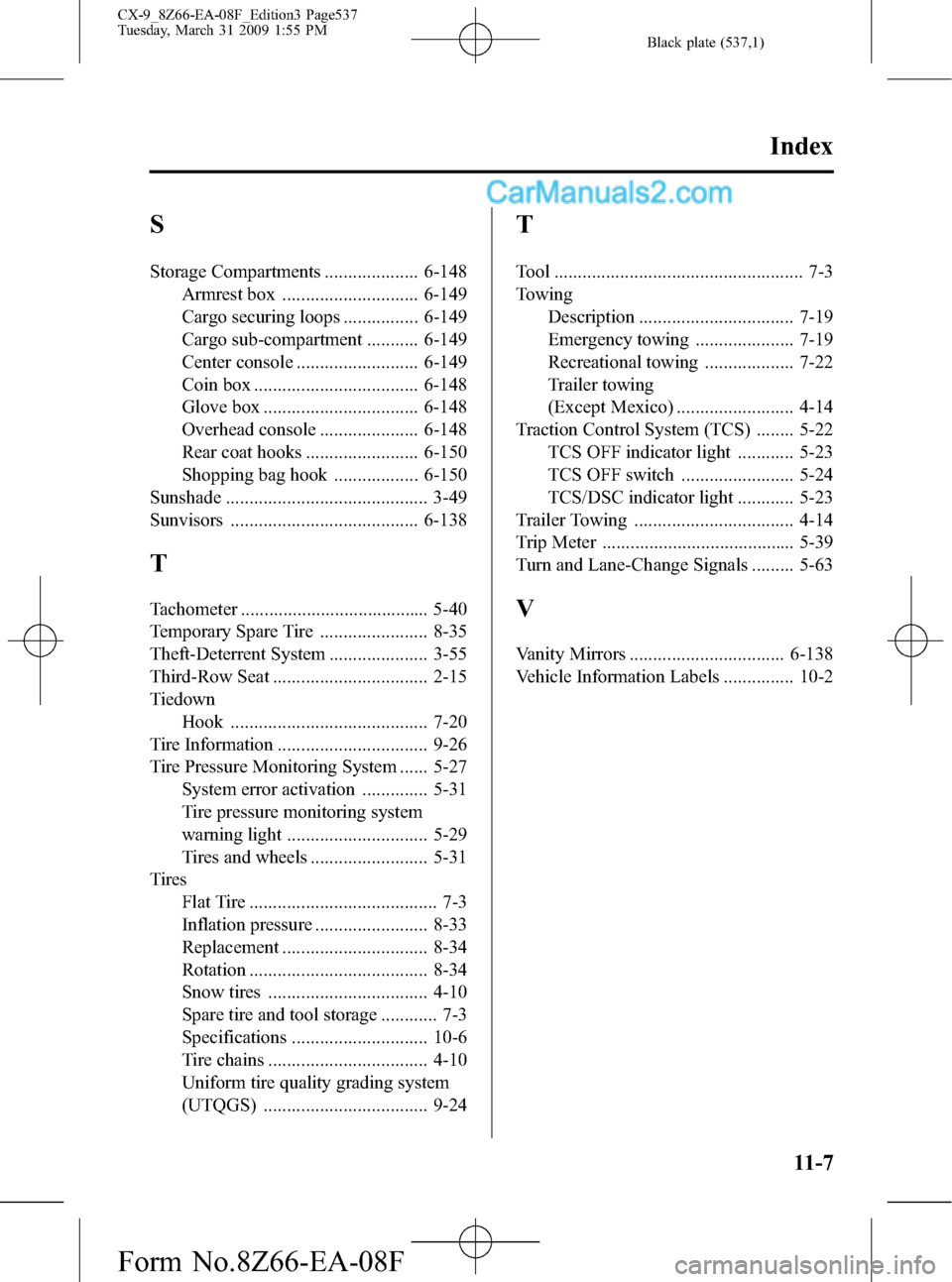
Black plate (537,1)
S
Storage Compartments .................... 6-148
Armrest box ............................. 6-149
Cargo securing loops ................ 6-149
Cargo sub-compartment ........... 6-149
Center console .......................... 6-149
Coin box ................................... 6-148
Glove box ................................. 6-148
Overhead console ..................... 6-148
Rear coat hooks ........................ 6-150
Shopping bag hook .................. 6-150
Sunshade ........................................... 3-49
Sunvisors ........................................ 6-138
T
Tachometer ........................................ 5-40
Temporary Spare Tire ....................... 8-35
Theft-Deterrent System ..................... 3-55
Third-Row Seat ................................. 2-15
Tiedown
Hook .......................................... 7-20
Tire Information ................................ 9-26
Tire Pressure Monitoring System ...... 5-27
System error activation .............. 5-31
Tire pressure monitoring system
warning light .............................. 5-29
Tires and wheels ......................... 5-31
Tires
Flat Tire ........................................ 7-3
Inflation pressure ........................ 8-33
Replacement ............................... 8-34
Rotation ...................................... 8-34
Snow tires .................................. 4-10
Spare tire and tool storage ............ 7-3
Specifications ............................. 10-6
Tire chains .................................. 4-10
Uniform tire quality grading system
(UTQGS) ................................... 9-24
T
Tool ..................................................... 7-3
Towing
Description ................................. 7-19
Emergency towing ..................... 7-19
Recreational towing ................... 7-22
Trailer towing
(Except Mexico) ......................... 4-14
Traction Control System (TCS) ........ 5-22
TCS OFF indicator light ............ 5-23
TCS OFF switch ........................ 5-24
TCS/DSC indicator light ............ 5-23
Trailer Towing .................................. 4-14
Trip Meter ......................................... 5-39
Turn and Lane-Change Signals ......... 5-63
V
Vanity Mirrors ................................. 6-138
Vehicle Information Labels ............... 10-2
Index
11-7
CX-9_8Z66-EA-08F_Edition3 Page537
Tuesday, March 31 2009 1:55 PM
Form No.8Z66-EA-08F